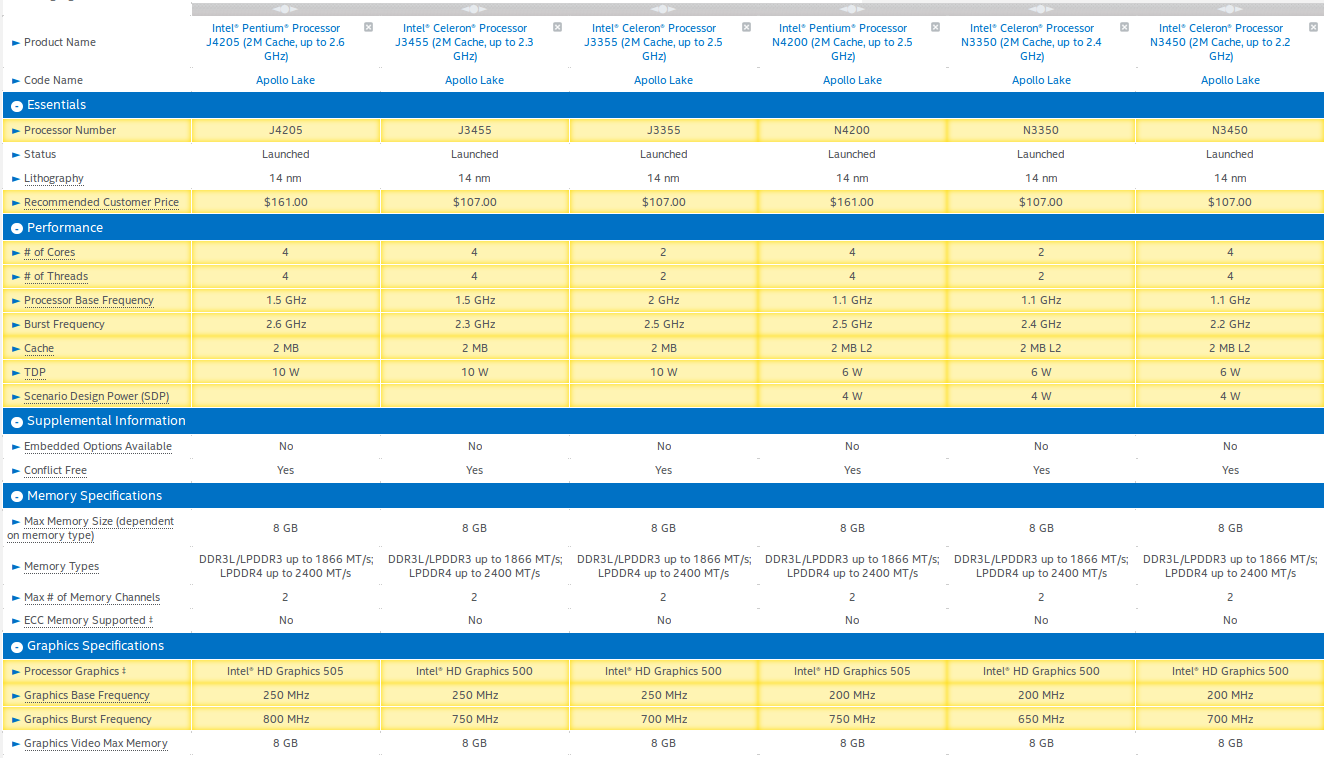Intel has been talking about Apollo Lake processor family, successor of Braswell family, and even showcased some Apollo Lake NUCs, but AFAIK, so far the company did not actually disclose any part numbers for the new processors. That has changed since Intel has now listed 6 “Formerly Apollo Lake” Celeron and Pentium processors on their website.

There are three processor for mobile (read laptop) devices (Nxxx parts), and three for desktop (Jxxx parts):
- For tablets, notebooks, 2-in-1 hybrids:
- Celeron N3350 dual core processor @ 1.1 GHz / 2.4 GHz (Burst frequency) and 12 EU Intel HD graphics 500 @ 200 MHz / 650 MHz (Burst freq.); 6W TDP
- Celeron N3450 quad core processor @ 1.1 GHz / 2.2 GHz (Burst frequency) and 12 EU Intel HD graphics 500 @ 200 MHz / 700 MHz (Burst freq.); 6W TDP
- Pentium N4200 quad core processor @ 1.1 GHz / 2.5 GHz (Burst frequency) and 18 EU Intel HD graphics 505 @ 200 MHz / 750 MHz (Burst freq.); 6W TDP
- For mini PCs:
- Celeron J3355 dual core processor @ 2.0 GHz / 2.5 GHz (Burst frequency) and 12 EU Intel HD graphics 500 @ 250 MHz / 700 MHz (Burst freq.); 10W TDP
- Celeron J3455 quad core processor @ 1.5 GHz / 2.3 GHz (Burst frequency) and 12 EU Intel HD graphics 500 @ 250 MHz / 700 MHz (Burst freq.); 10W TDP
- Penitum J4205 quad core processor @ 1.5 GHz / 2.6 GHz (Burst frequency) and 18 EU Intel HD graphics 505 @ 250 MHz / 800 MHz (Burst freq.); 10W TDP
All processors come in FCBGA1296 package, supports up to 8GB dual channels memory, eDP/DP/HDMI/MIPI-DSI graphics output, up to 6 PCIe lanes, 8 USB 2.0/3.0 ports, and 2x SATA 6.0 Gbps ports. So both mobile and desktop processors have the same features, but the desktop versions are clocked a little higher, providing better performance at the cost of higher power consumption.
Via FanlessTech

Jean-Luc started CNX Software in 2010 as a part-time endeavor, before quitting his job as a software engineering manager, and starting to write daily news, and reviews full time later in 2011.
Support CNX Software! Donate via cryptocurrencies, become a Patron on Patreon, or purchase goods on Amazon or Aliexpress




